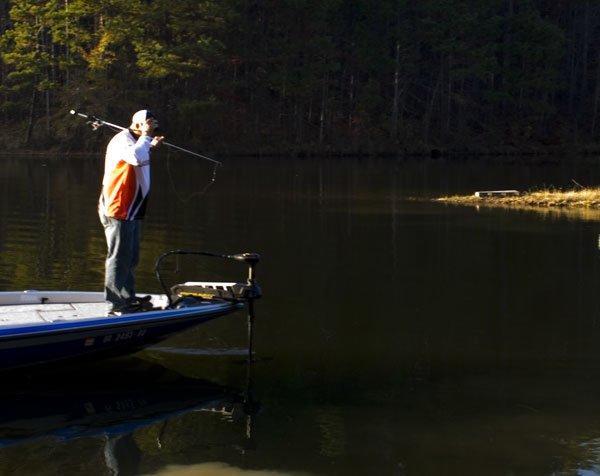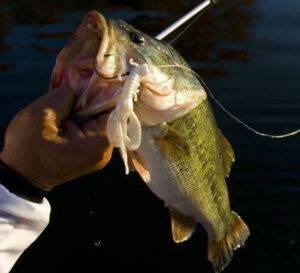Catching spawning bass is something that many anglers look forward to throughout the entire year. Sure, catching them on crankbaits, big worms and spinnerbaits is fun, but it doesn’t get much better than watching a fat-bellied female inhale your bait. In some parts of the country, this yearly phenomenon is already underway.
Phoenix Boats pro Bobby Lane has spent his entire life honing his bed fishing skills in the shallow waters of Florida and has been able to apply his skillset all over the United States. If there’s somebody we all could learn from about bed fishing, Lane is the man to talk to. His 6 tips will help you catch more spawning bass this year.
Check back often
It happens to tournament anglers all the time—you spend your entire practice locating dozens of big bass sitting on their beds and when tournament day finally rolls around, your sweet spots are a barren wasteland of empty beds. Lane never lets these instances fluster him because he knows the fish will be back.
“I see so many anglers getting spun out when the beds they’ve found the previous day are empty,” Lane said. “It’s absolutely essential to come back to these empty beds around the noon or one o’clock hour. More times than not, I’ve really dominated in tournaments when the fish don’t move up until late in the day.”
Empty bass beds don’t always mean the bass have totally abandoned them. Sometimes a slight weather change can pull them off, so don’t throw away your game plan. Chances are, the bass haven’t moved very far. Instead, they’re just waiting for the right moment to pull up. The only way you’ll know is if you keep checking back as the day progresses.
Have patience
We’ve all seen the television shows that make bed fishing look like the best thing since sliced bread. It’s definitely a load of fun, but you can’t expect to load the boat with 20 pounds in a matter of minutes.
“Patience is the first and foremost thing you have to remember,” Lane said. “You’re coming into a bass’ home, so they’re naturally going to act very peculiar. If somebody comes into your home messing with your house, you’re dang sure going to raise a brow and act a little funny, too.”
When you approach a bass bed and notice the big female darting away, don’t take that as your cue to leave and continue your search elsewhere. More than likely, a few small adjustments are all that’s needed to catch the weary bass.
“If a bass leaves the bed I’m fishing, I take that as a sign that I need to reposition my boat and approach it from a different angle,” Lane said. “I’ll slowly back off, give the fish a little while to relax and try again—it’s a chess game.”
Patience also pays off when you’re looking for the bona fide giant bass. Although it’s tempting to scour the 1- to 3-foot depth range, you’ll often find the bigger bass in deeper water.
“Don’t just do what’s easiest and fish the most accessible areas for the most visible fish,” Lane said. “A lot of huge females will bed in the 6- to 10-foot range and it takes a lot of patience and hard work to find those fish. If you keep at it, you’ll be rewarded in the long run.”
Be stealth
Spawning bass are particularly paranoid and skittish, making them easily spooked by even the slightest disturbance. When targeting these bass, it’s important to go the extra mile to be as quiet as possible.
“I never, and I mean never, put my trolling motor over 50 percent when I’m fishing for spawning bass,” said Lane. “This is when a push pole is an absolute must-have. Half of the guys in the Elite event at St. Johns River had one because they allow you to get much closer to the fish.”
Working a push pole all day is no easy task, however. It takes a lot of effort to push a heavy bass boat around, so it’s good practice to stay in shape throughout the spawning season
Watch the fish, not your bait
Keen observation skills are never more important in bass fishing than during the spawn. Paying close attention to the bass’ behavior can make all the difference in catching the bass of a lifetime.
“Every bass is different and you’ve got to understand each fish you’re targeting—they’ll all react in different ways,” Lane said. “Never get fixated on your bait hopping up and down in the bed. You’ll be able to catch some buck bass doing this, but you’ve got to really watch the big females. Work your bait different ways and learn which movements really make her blood boil.”
In order to better read the fish, always watch for two behaviors—flaring fins and tight circles. When a bass has absolutely “had it” with your antics, you’ll start to see them swim in very tight circles around your bait with both their fins and gills flared. If you notice this behavior, you’re doing the right things to provoke an aggressive strike.
Fine tune your tackle
It’s possible to get by with subpar tackle throughout other times of the year, but during the spawn, Lane makes sure to use the highest quality gear he can get his hands on. In his mind, it all starts with quality fishing line
“I use 65-pound Spiderwire Ultracast Ultimate Braid with a double Palomar knot in every bed fishing situation,” Lane said. “I don’t care if I’m in crystal clear water—I’ll still use big braid. The fish couldn’t care less about your line—they just want your bait out of their bed. When you get a bite with heavy braid, your chances of landing those fish are as close to 100 percent as you can get.”
When it comes to his rod selection, he utilizes different rod lengths and actions depending on the size of the fish he’s looking at. For bass in the 3- to 5-pound range, he opts for a 7-foot, 1-inch heavy-action or a 7-foot, 4-inch medium-heavy Abu Garcia Veritas Casting Rod. If he’s targeting bass above 5-pounds, he breaks out the big guns—a 7-foot, 11-inch heavy-action Abu Garcia Veritas Casting Rod.
“Matching your rod with the size of the fish you’re after is a big deal,” Lane said. “If you set the hook on a 3-pounder with a rod that’s too stiff, you run the risk of either pulling the hook through their lip or sending it sailing over your boat. When stuff like that happens, you’re going to lose a lot of valuable fish.”
A high-speed reel can be a lifesaver when fishing for spawning bass. Although you’ll usually be fishing in close quarters with the fish, you need to be prepared for anything.
“I use a left-handed 7.1:1 Abu Garcia REVO STX Generation 3 Casting Reel,” Lane said. “It happens all the time—you set the hook on a bed fish and it runs straight at the boat. You’ve got to have a reel that’s fast enough to give you a chance at catching up with her.”
Try different baits
Small changes in bait selection can prove invaluable throughout the spawning period. What one fish bites, another one may ignore, so keeping an open mind will give you a better chance of fooling more big bass
“I like a 4-inch Berkley Havoc Bobby Lane’s Craw Fatty,” Lane said. “We designed it to be a killer bed fishing bait and it has caught a ton of big bass for me. You still have to switch things up sometimes depending on the mood of the fish, so I also like to flip a Berkley Havoc Rocket Craw to give them a different look. If your fishing highly pressured waters, I’d even try a swimbait. It sounds odd, but the results can be amazing.”
Catching spawning bass is one of the most exciting techniques in bass fishing, and although it can be a bit frustrating at times, it gives you a great opportunity to catch enormous bass. If you stay patient and stealthy, understand the bass’ behavior and keep an open mind, you can have the time of your life this spring.













